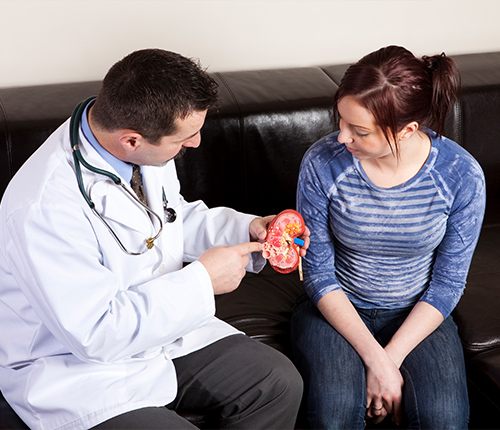1 IN 10 PEOPLE WILL DEVELOP
Kidney Stones
One of the most painful conditions, kidney stones are also one of the most common. Annually, kidney stones prompt patients to make about 2.7 million doctor visits and more than 600,000 trips to the emergency room.

Causes
A kidney stone is a hard mineral or chemical deposit that develops within the kidney. When dissolved minerals in the urine build up, stones can form. Stones tend to grow larger over time. Some stones stay in the kidney while others fall down into the ureter (the tube that transports urine from the kidney to the bladder) and block the flow of urine causing pain.
The Risk Factors
Stones occur more frequently in men than in women. Once a person gets more than one stone, others are likely to develop. A family history of kidney stones, urinary tract infections, kidney disorders and certain metabolic disorders such as hyperparathyroidism are also linked to stone formation. Gout, diabetes, prior intestinal bypass surgery for obesity, and inflammatory bowel disease are also risk factors.


What to Look For
Some people with stones have no symptoms at all or they have relatively mild symptoms such as blood in the urine, the need to urinate more often, or a burning sensation while urinating. Others may experience extreme pain, which begins suddenly when a stone obstructs the urinary tract. Typically, a person feels a sharp, cramping pain in the back and side in the area of the kidney or in the lower abdomen. Sometimes nausea and vomiting occur.
Treating Your Condition
- Contact Us
- Medical Expulsive Therapy (MET)
- Extracorporeal Shockwave Lithotripsy (ESWL)
- Ureteroscopy
- Percutaneous Nephrolithotomy
Ready to learn more? Contact us today to get started.
When the stones are small, not causing significant pain, and likely to pass, medication is prescribed to help facilitate the passage of the stone out of the urinary tract.
Shockwaves are used to break down the kidney stones into sand-like particles that are easily passed. ESWL is a same-day outpatient procedure performed under anesthesia with a short recovery time.
The surgeon passes a small instrument called a ureteroscope through the urethra and bladder into the ureter. The stone is either removed or shattered with a special laser. A small tube or stent may be left in the ureter for several days to help the lining of the ureter heal.
When the stone is large or in a location that does not allow effective use of ESWL or ureteroscopy, PCNL is an option. The surgeon makes a tiny incision in the back to directly access the kidney and uses an instrument called a nephroscope to remove the stone. Generally, patients stay in the hospital overnight or a few days.

